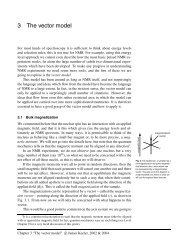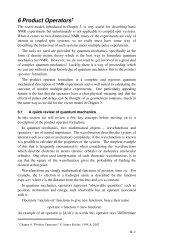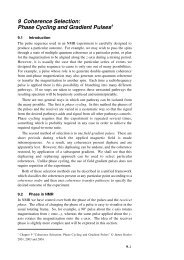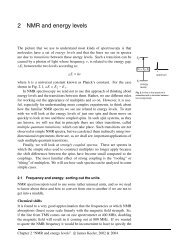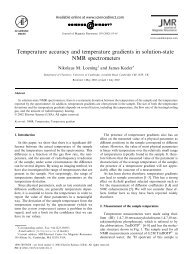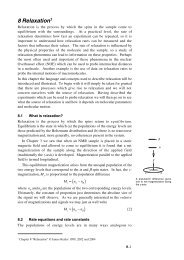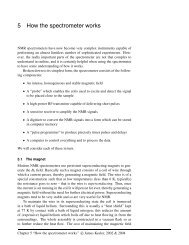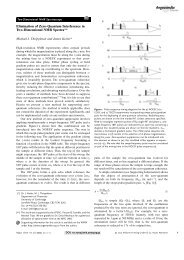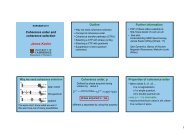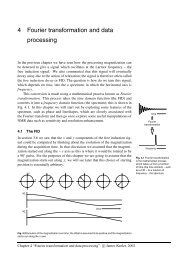Phase Cycling and Gradient Pulses - The James Keeler Group
Phase Cycling and Gradient Pulses - The James Keeler Group
Phase Cycling and Gradient Pulses - The James Keeler Group
Create successful ePaper yourself
Turn your PDF publications into a flip-book with our unique Google optimized e-Paper software.
1 0 0 0 0<br />
2 90 90 180 0<br />
3 180 180 0 0<br />
4 270 270 180 0<br />
We can play one more trick with this phase cycle. As the third pulse is required<br />
to achieve the transformation ∆p = –3 or +1 we can alter its phase by 180° <strong>and</strong><br />
compensate for this by shifting the receiver by 180° also. Doing this for steps 2<br />
<strong>and</strong> 4 only gives<br />
step 1st pulse 2nd pulse 3rd pulse receiver<br />
1 0 0 0 0<br />
2 90 90 0 180<br />
3 180 180 0 0<br />
4 270 270 0 180<br />
This is exactly the cycle proposed in section 9.5.5.4.<br />
9.5.9 Further examples<br />
In this section we will use a shorth<strong>and</strong> to indicate the phases of the pulses <strong>and</strong><br />
the receiver. Rather than specifying the phase in degrees, the phases are<br />
expressed as multiples of 90°. So, EXORCYCLE becomes 0 1 2 3 for the<br />
180° pulse <strong>and</strong> 0 2 0 2 for the receiver.<br />
9.5.9.1 Double quantum spectroscopy<br />
A simple sequence for double quantum spectroscopy is shown below<br />
τ<br />
τ<br />
t 1<br />
t 2<br />
9–30<br />
2<br />
1<br />
0<br />
–1<br />
–2<br />
Note that both pathways with p = ±1 during the spin echo <strong>and</strong> with p = ±2<br />
during t 1<br />
are retained. <strong>The</strong>re are a number of possible phase cycles for this<br />
experiment <strong>and</strong>, not surprisingly, they are essentially the same as those for DQF<br />
COSY. If we regard the first three pulses as a unit, then they are required to<br />
achieve the overall transformation ∆p = ±2, which is the same as that for the<br />
first two pulses in the DQF COSY sequence. Thus the same cycle can be used<br />
with these three pulses going 0 1 2 3 <strong>and</strong> the receiver going 0 2 0 2.<br />
Alternatively the final pulse can be cycled 0 1 2 3 with the receiver going 0 3<br />
2 1, as in section 9.5.5.4.<br />
Both of these phase cycles can be extended by EXORCYCLE phase cycling<br />
of the 180° pulse, resulting in a total of 16 steps.<br />
9.5.9.2 NOESY<br />
<strong>The</strong> pulse sequence for NOESY (with retention of absorption mode lineshapes)<br />
is shown below



